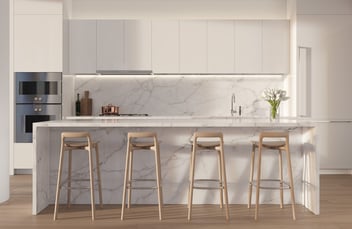How to Care for and Maintain Your Marble
Simple care and maintenance will help you preserve your marble’s beauty for generations to come. Below are regular sealing and cleaning recommendations by the Marble Institute of America:
Sealing Natural Stone
The type of stone, its finish, its location, and how it is maintained all need to be considered when determining how to protect the stone.
The Marble Institute of America’s position on sealers is as follows:
The Marble Institute of America (MIA) recognizes the benefits that sealers can provide in certain applications. MIA recommends that care be exercised in the application of any chemical to a stone’s surface. Although normally innocent in and of themselves, some sealers have reportedly reacted with some cleaning/maintenance chemicals and/or with components within the stone surface, causing some reactions.
If you decide to seal your stone, make sure you understand the different sealers available on the market:
Topical Sealers are coatings (film formers) designed to protect the surface of the stone against water, oil, and other contaminants. They are formulated from natural wax, acrylic, and other plastic compounds. When a topical sealer is applied, the maintenance program often shifts from a program focused on stone care to a
program focused on the maintenance of the sealer
Impregnators are water or solvent-based solutions that penetrate below the surface and become repellents. They are generally hydrophobic (water-repelling), but are also oliophobic (oil-repelling). Impregnators keep contaminants out, but do not stop the interior moisture from escaping. These products are considered “breathable,” meaning they have vapor transmission.
Before sealing, always read the manufacturer’s warranty and instructions.
Cleaning Do’s and Don’ts
Do dust and mop marble floors frequently.
Do clean surfaces with mild detergent or stone soap.
Do thoroughly rinse and dry the surface with clean, clear water after washing.
Do blot up spills immediately.
Do protect floor surfaces with non-slip mats or area rugs and countertop surfaces with coasters, trivets, or placemats.
Don’t use vinegar, lemon juice, or other cleaners containing acids on marble
Don’t use cleaners that contain acid such as bathroom cleaners, grout cleaners, or tub & tile cleaners.
Don’t use abrasive cleaners such as dry cleansers or soft cleansers.
Don’t mix bleach and ammonia; this combination creates a toxic and lethal gas.
Don’t ever mix chemicals together unless directions specifically instruct you to do so.
Don’t use vacuum cleaners that are worn. The metal or plastic attachments or the wheels may scratch the stone’s surface.
Daily Cleaning Procedures and Recommendations
Countertop Surfaces:
Normal maintenance involves periodic washing with clean, potable water and neutral (pH 7) cleaners. Soapless cleaners are preferred because they minimize streaks and film. Mild, phosphate-free, biodegradable liquid dishwashing soaps or powders or stone soaps are acceptable if rinsing is thorough.
Wet the stone surface with clean water. Using the cleaning solution (following manufacturer’s directions), wash in small, overlapping sweeps. Work from the bottom up if it is a vertical surface. Rinse thoroughly with clean, potable water to remove all traces of soap or cleaner solution. Change the water in the rinse pail frequently. Dry with soft cloth and allow.
Clean stone surfaces with a few drops of neutral cleaner, stone soap (available at hardware stores or from your stone dealer), or a mild liquid dishwashing detergent and warm water. Use a clean, soft cloth for best results. Too much cleaner or soap may leave a film and cause streaks. Do not use products that contain lemon, vinegar, or other acids on marble or limestone. Rinse the surface thoroughly after washing with the soap solution and dry with a soft cloth. Do not use scouring powders or creams; these products contain abrasives that may scratch the surface.
Floor Surfaces:
Dust mop interior floors frequently using a clean, non- treated dry dust mop. Sand, dirt, and grit do the most damage to natural stone surfaces due to their abrasiveness. Mats or area rugs inside and outside an entrance will help to minimize the sand, dirt, and grit that will scratch the stone floor. Be sure that the underside of the mat or rug is a non-slip surface.
Bath and Other Wet Areas:
Soap scum can be minimized by using a squeegee after each use. To remove soap scum, use a non-acidic soap scum remover or a solution of ammonia and water (about 1/2 cup ammonia to a gallon of water). Frequent or over-use of an ammonia solution may eventually dull the surface of the stone.
Outdoor Pool and Patio Areas:
In outdoor pool, patio, or hot tub areas, flush with clear water and use a mild bleach solution to remove algae or moss.
Exterior Stone Maintenance:
The large expanses of stone generally found on exterior applications may make it impractical to perform normal maintenance on a frequent basis. Large installations, however, should be given periodic overall cleaning as necessary to remove accumulated pollutants. Easily accessible stone surfaces such as steps, walkways, fountains, etc., should be kept free of debris and soiling by periodically sweeping and washing with water.
Normal maintenance should include periodic inspection of stone surfaces for structural defects, movement, deterioration, or staining.



